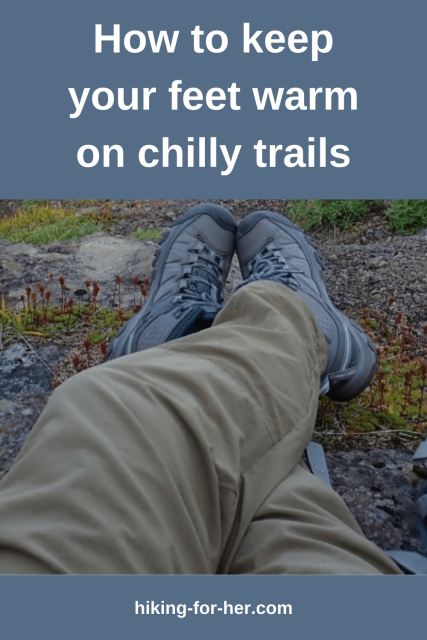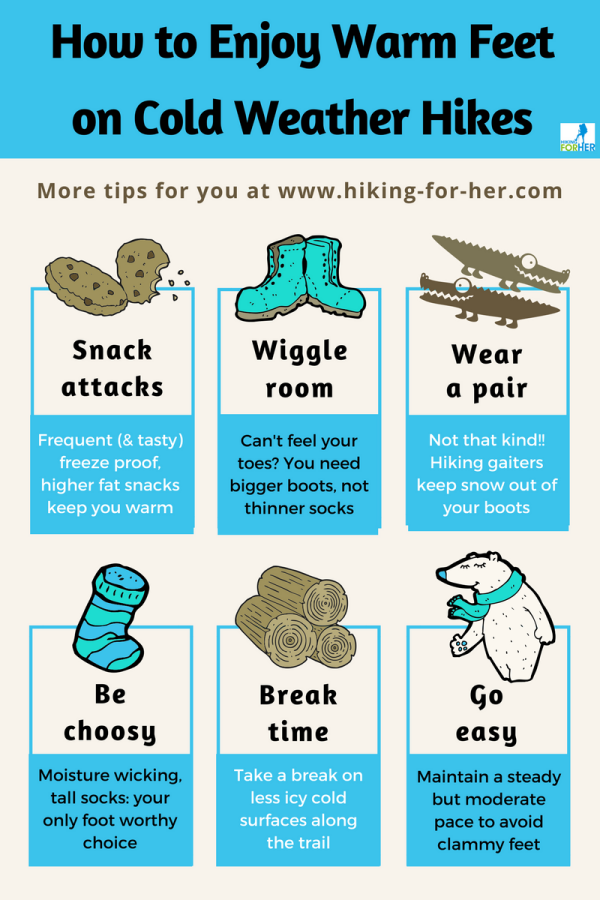
Warm Feet Hiking Tips:
Cold Weather Shouldn't
Defeat You
By Diane Spicer
Warm feet hiking tips put you in a position of absolute control over your own health and well being on a cold weather hike or snow shoeing adventure.
Being proactive by reading - and then deploying - these best warm feet hiking tips will protect your margin of outdoor safety.
Plus increase the chances of enjoying your hike even when temperatures plummet and your cold feet start talking to you.
Let's get started. Because if we stand around, your feet will get cold ;)
Warm feet hiking tips
start with your brain
It's a mistake I see being made over and over again.
- I call it the "it won't be that bad" mentality.
As in, "It won't be that cold and my boots won't get that wet and I won't be out that long."
Feel free to fill in your own personal favorites.
But here's the thing: if you're heading out into wet, windy, cold, unpredictable conditions, who's in charge of your health and safety?
Your mirror knows the answer!
So use your brain to remember these important warm feet hiking tips when in fact you DO get that cold and that wet.
Banish summer socks
If your sock drawer is anything like mine, certain pairs of socks tend to float up to the top with great regularity, including my hiking socks.
And it's easy to get complacent and reach for lightweight or midweight hiking socks, when in fact, for cold weather hiking, you need to go big or stay home.
Also, you absolutely need moisture wicking socks for cold trails. Wet feet can get that way from moisture in the environment, or the moisture you create inside your boots.
Either way, choose socks which are engineered to absorb moisture and allow your body temperature to remain constant.
Here are my recommendations:
Your boots
are connected to your brain
Did we just stray from warm feet hiking tips?
- What the heck does that mean?
It means that your summer boots and low cut trail shoes are not a good choice for muddy, snowy trails.
You'll need a pair of boots with a higher cut, and waterproof exterior.
So allow your brain to take charge and say no way to feather weight, absorbent trail footwear.
My winter boot recommendations are here.
- A recent Baffin boots review (high quality Canadian design) is here.
Tip: Make sure you have enough room in your boots for those thick, wicking hiking socks AND your toes.
- If you can't wiggle your digits, you need bigger boots - not thinner sock.
Pack a purposeful lunch
Calories are worth more than gold to you during a cold hike. They are your cellular fuel, and running out of them means your gas tank -well, tanks.
If you're used to rabbit food in your hiking lunch sack, think again.
- Carrot sticks and apples enter your warm mouth as cold, crunchy, calorie poor food, and take energy to crunch but don't give a lot back to your muscle cells.
Include calorie dense, satisfying foods with high quality fats, and snack every hour or so if you're working hard on the trail.
Tip: Buy yourself a durable double wall insulated bottle like this one, and fill it to the brim with hot chocolate. Bring something fun and caloric to toss in, just before you drink it.
Know thy enemy
As a hiker, you know the importance of keeping your wits about you.
But do you know the signs and symptoms of cold related tissue damage? One of them is becoming dim witted.
Get up to speed quickly:
As a solo hiker, be ruthless about spotting when you're heading into trouble.
- Employ the "watch yourself like a hawk" strategy to examine every brain fart, clumsy move, and desire to cut corners.
Hiking in a group?
- Mentally set your intention at the beginning of the hike to check in often with your trail buddies.
- When you notice someone mumble or stumble, gently follow up with her and rule out cold weather danger signs.
- Take control of the hiking pace when someone wants to start out too fast (and thus create a rainstorm inside your clothing and boots).
- Bring extra food to share with hiking buddies who didn't bring enough to eat. This is one of the best warm feet hiking tips I can give you, because if someone sits down and declares their feet are frozen, they might be correct. Big trouble!!
Warm feet hiking tips continue
with your behavior on the trail
Forget about sitting down while you snack and enjoy your hot beverage, unless you take a few precautions:
- Carry a waterproof, lightweight heat reflective tarp or waterproof blanket. Drape it under and over your backpack. Perch on top of your cozy little throne for several minutes while you refuel.
- If you want to keep standing up, notice where your feet are. Can you put something between the cold ground and your feet, such as a log or extra jacket?
- If you routinely hike with a small pad to sit on, in winter make it a "standing on" pad.
Proactive protective habits
for winter hikers
When you stepped onto the trail, you presumably had normal body temperature and adequate circulation to your limbs and digits.
Keep that wonderful trend going by staying warm, rather than reacting to a sensation of being chilled.
These warm feet hiking tips that may not seem directly related to your feet, but will keep them toasty warm:
- wear a hat or warm headband throughout the day
- don gloves at the beginning of your hike, especially if you're clutching trekking poles, camera gear, or anything else that causes sustained muscle contractions in your hands
- put on a pair of gaiters to discourage snow from finding its way into your boots
- keep a steady, manageable pace which doesn't tax your ability to pick up and plant your feet safely
- wear traction devices on your boots if you face an icy trail, to avoid foot injuries that would slow you down and imperil your ability to return to the trail head before dark
- wiggle your fingers and toes every so often, to allow warm, oxygenated blood to flow into them and just to be sure you still can!
Ways to warm up those cold feet
If you're overnighting or backpacking during winter, you need to have a "get warm fast" strategy in your mental toolkit.
Include smart moves like these:
- thick, dry socks waiting for you in your sleeping bag
- an insulated water bottle to fill with hot water and rest between your feet as you sleep
- foot massage, either self i
nflictedadministered, or traded with your tent partner - insert toe warmers into your boots or sleeping bag
- a fleece scarf to wind around each foot + foot warmer = heavenly heat for your feet
- a warm sleeping hat that stays put throughout your thrashings
- a thin infinity scarf to guard your neck against chilly breezes
Tent tip: Toss mildly damp (not wringing wet) socks between your sleeping bag and sleeping pad, to absorb body heat before the dawn's early light.
More ways to stack the odds
of warm feet in your favor
when camping cold
- Situate your campsite where morning sun (if you're lucky enough to have any) can strike your tent.
- Budget in fuel for extra warm water after your evening meal for a quick but warming face and neck wash up.
- Plan your daylight hours of travel carefully, allowing adequate time to set up camp in sun-softened snow.
- Avoid moving around beneath snow loaded branches, which have a tendency to dump the cold stuff onto you with no warning.
Warm feet hiking tips
grand finale
Don't go cold weather hiking or snowshoeing without thinking carefully about preserving the ability of your feet to get you back home.
The first, and worst, mistake you can make: complacency.
It's my sincere hope that you'll stop reading right now and do two things:
1. Look carefully at the socks and boots you plan to hike in during the cold weather hiking season.
2. Consider adding a few things to your backpack:
- simple emergency shelter such as a tarp
- bivvy sack or space blanket
- extra socks
- an extra 500 calories of nutrient dense, easy to chew, won't freeze solid, hiking food
- the tastiest tea for winter hikers
Here's wishing you warm feet - and amazing winter adventures - on the trail now that you know all these warm feet hiking tips.
Now let's tackle how to prevent cold hands!
Home page > Winter Hiking Tips >
Warm Feet Hiking Tips
Some links on this page take you to Hiking For Her affiliates, meaning companies and products that I trust with my own life when hiking in cold weather.
You pay nothing extra to purchase using these links, but it results in a small amount of money to flow into the HFH coffers.
The best result? More free trustworthy hiking tips for hikers around the globe. Thanks for your support of HFH's mission.
|
I get emails all the time about what I wear, eat, carry and love to use on the trail. That's
why I provide affiliate links to you: the best gear that I use myself and have seen used by other hikers is instantly
available for your consideration, and the gear company sends a few
pennies per dollar to this reader-supported hiking website. There is no added cost to you! Everyone ends up a winner: Great gear for you, strong gear companies, and more free hiking tips for everyone. Thanks very much for your support. It's warmly and sincerely appreciated. It also helps send these hiking tips to all your virtual trail buddies around the globe. |
 |



